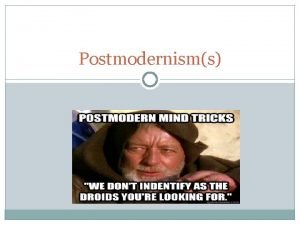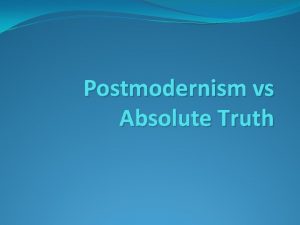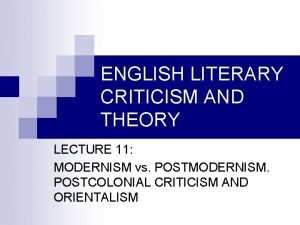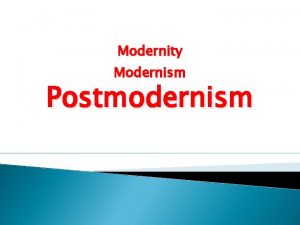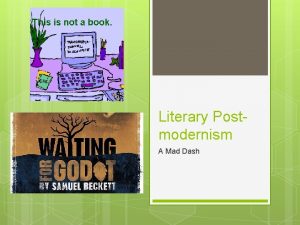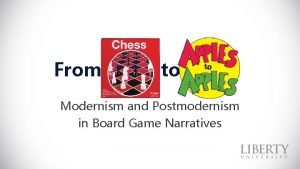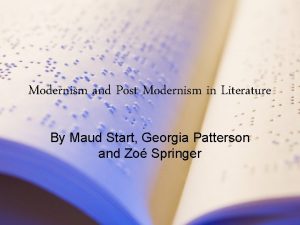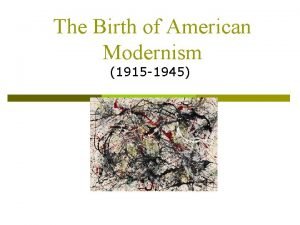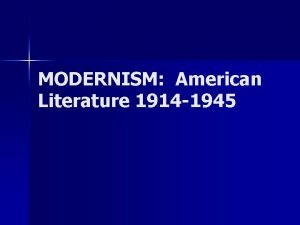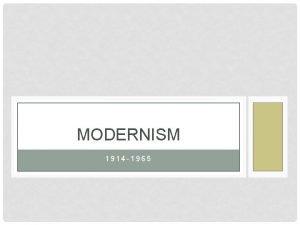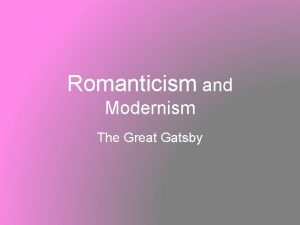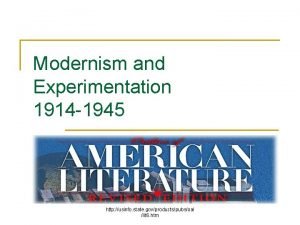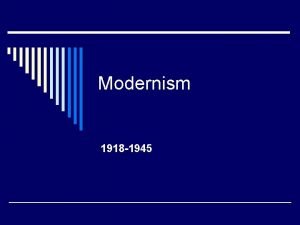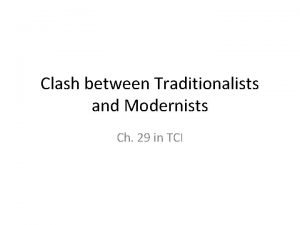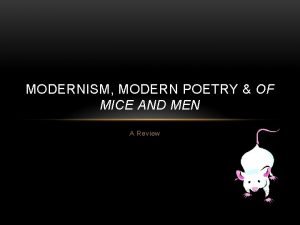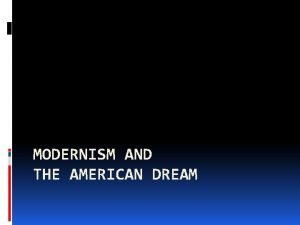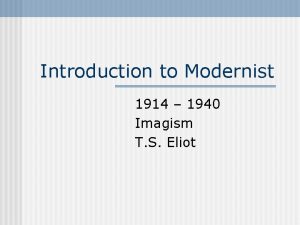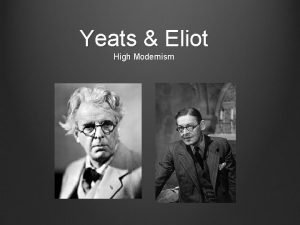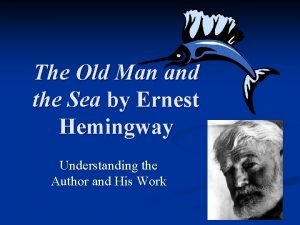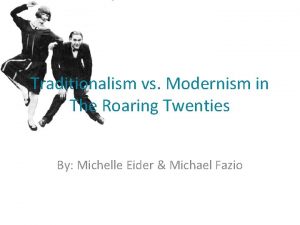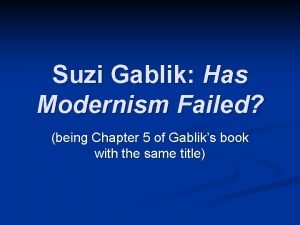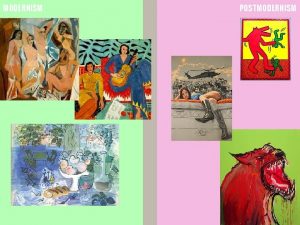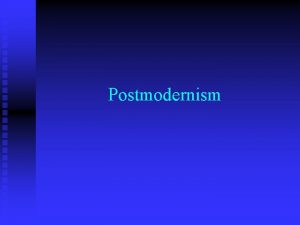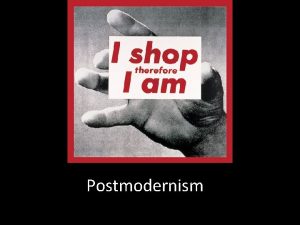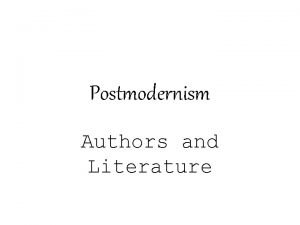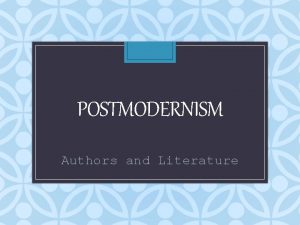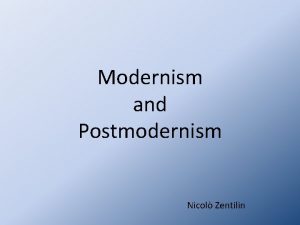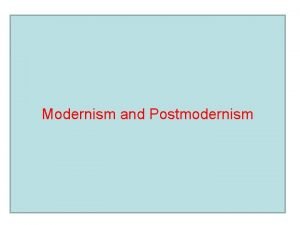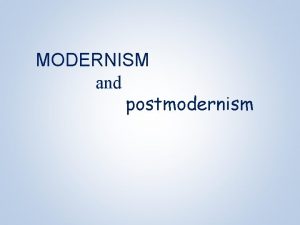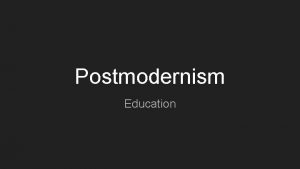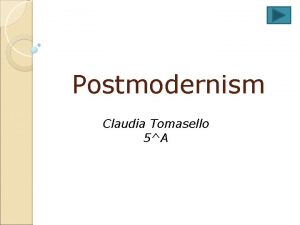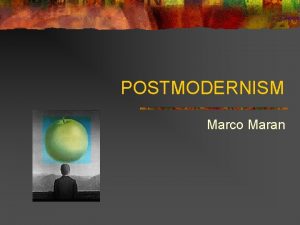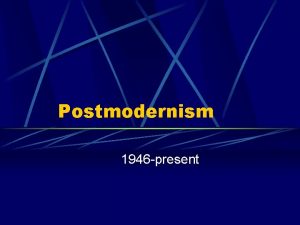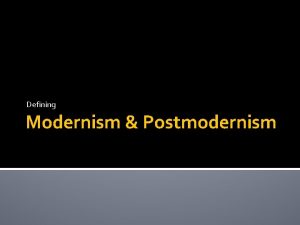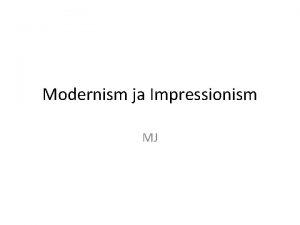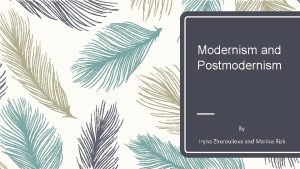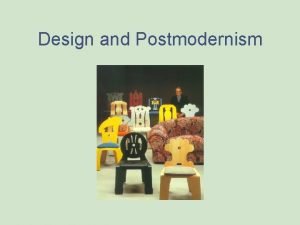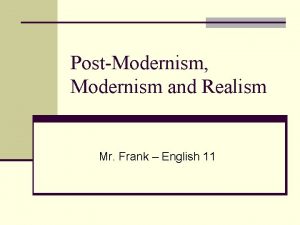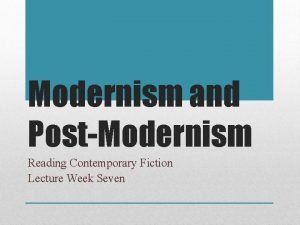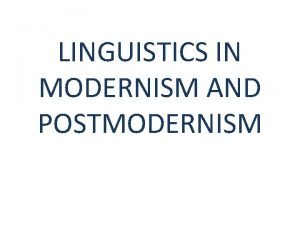Postmodernism Postmodernism and Modernism Po Mo is reactions



























- Slides: 27

Postmodernism

Postmodernism and Modernism • Po. Mo is: reaction(s) against Modernism; visible across all art forms • What is modernism? – Freedom and individuality – Optimism regarding technology – “impartial” evaluation of the work of art—Formalism and Greenberg – “Masterpieces, ” uniqueness, originality, and authenticity of the artwork all important – Linear sequence of progression – Fear/disdain of kitsch and middle class values/sensibilities – Binary Oppositions

Kitsch: lowbrow style of popular or massproduced art; often uses exaggerated sentimentality, nostalgia, or melodrama (tacky, cheesy, not serious).

Modernist Literature and Art (according to Klages) • Emphasis on impressionism and subjectivity, HOW of perception • Movement away from “objective” third-party narration • Rejection of traditional aesthetic theories, development of unique, experimental, or individual styles • Experimentation with meaning/language Klages says that Postmodernism continues all these trends of Modernism, the major difference is that while Modernism sees the fragmentation and dissolution of a stable subject as tragic, Postmodernism celebrates it. (I tend to think there’s more differences than that)

Modernity • History as fact/truth: memorize the facts • Western perspective, narrative of development or progress • Faith in traditional ideas of family, social order • Authenticity of originals • Mass consumption Post. Modernity § § § History as written by people in power; different histories or truths are possible Cultural pluralism, multiple perspectives and narratives Alternate methods of organizing morals and social structures Hyper-reality (MTV) and simulacra (copies without originals) Niches; small group identities (may belong to many groups)

Postmodern Cultural Relativism:

• A simulacrum (plural simulacra) is a copy without the qualities of the original, or in some cases, with no original at all. • Hyperreality: A condition in which what is real and what is artificial are blended together so seamlessly that you can’t tell the difference between them. • What are examples of things /places/movies/etc that you think may fit into these definitions?

Warhol, Brillo Boxes, 1964 Arthur Danto: “Why is something that looks exactly like a Brillo Box a work of art, but a Brillo box is not? ”

Hiroshi Sugimoto, Cheetah, 1980 from the Diorama series

Postmodernism: Basic Concepts • Blurring of all boundaries, especially between “high” and “low” culture, art, etc. • Rejection of all master narratives—All “truths” are contingent cultural constructs • Sense of fragmentation and decentered self, multiple conflicting identities • Mass-mediated reality

Pre-Postmodernist blurring of boundaries: Marcel Duchamp, Fountain, 1917

Parody/Pastiche: Vic Muniz and Pollock

Fred Wilson, Metalwork, 1793 -1880, detail from Mining the Museum, 1992 Postmodernism requires that we ask different questions about the artwork than Modernism, including: For whom was it created? Who controls the narrative? What power structures does it support?

Postmodernism and Architecture • Architecture adopted postmodern characteristics first • Architects no longer stayed true to one style or era of building--combined features of different styles. • Buildings were playful and function no longer dictated form. • Charles Jencks: architecture should be eclectic, playful and based on popular appeal • Michael Graves, Portland Building, Portland, OR, 198082

James Stirling, Neue Staatsgalerie, Stuttgart 1977 -84

Neoclassical pastiche

Pastiche of Ancient Egypt

Another Pastiche building in China

Appropriation • Takes something and incorporates it into something else, while recontextualizing or decontextualizing the original thing or concept. • Cultural appropriation • Artistic appropriation • It’s been around for a long time, but is a basic strategy of postmodernist art. Appropriation reminds us that originality is a myth

Appropriation: Titian—Manet—Morimura

Barbara Kruger, Untitled (We don’t need another hero), 1985 • Postmodern works often use ambiguous language: who is “we”? Who is speaking? • Questions traditional roles and values

Jeff Koons, New Hoover, 1981 -87

Koons, Michael Jackson and Bubbles, 1988

Vik Muniz, Double Mona Lisa, After Warhol (Peanut Butter and Jelly), 1999 Warhol, Mona Lisa, 1963 Duchamp, L. H. O. O. Q. , 1919

Vik Muniz, Saturn Devouring his Children (After Goya), 2005 original 1820 -23

Richard Prince, Untitled (Cowboy), 1989, 127 x 178 cm

Sherrie Levine, After Marcel Duchamp, 1995
 Postmodernism vs modernism literature
Postmodernism vs modernism literature Postmodernism vs modernism literature
Postmodernism vs modernism literature Post modernist
Post modernist Postmodernity
Postmodernity Modernist vs postmodernist
Modernist vs postmodernist Premodern modern postmodern timeline
Premodern modern postmodern timeline Dash in literature
Dash in literature Postmodernism language games
Postmodernism language games Post modernism literature
Post modernism literature Chemical reactions section 2 classifying chemical reactions
Chemical reactions section 2 classifying chemical reactions Reduction half reaction
Reduction half reaction Chemical reactions section 2 classifying chemical reactions
Chemical reactions section 2 classifying chemical reactions Chemical reactions section 3 reactions in aqueous solutions
Chemical reactions section 3 reactions in aqueous solutions Unit 5 chemical reactions answers
Unit 5 chemical reactions answers American modernist novels
American modernist novels Modernism in literature
Modernism in literature Modernism and the american dream
Modernism and the american dream Romantic vs realist
Romantic vs realist Modernism and experimentation
Modernism and experimentation Realism vs modernism
Realism vs modernism Chapter 29 the clash between traditionalism and modernism
Chapter 29 the clash between traditionalism and modernism Who wrote this poem
Who wrote this poem Modernism and the american dream
Modernism and the american dream Characteristics of imagist poetry
Characteristics of imagist poetry Leda and the swan modernism
Leda and the swan modernism The old man and the sea modernism
The old man and the sea modernism Traditionalism vs modernism
Traditionalism vs modernism Suzi gablik
Suzi gablik
